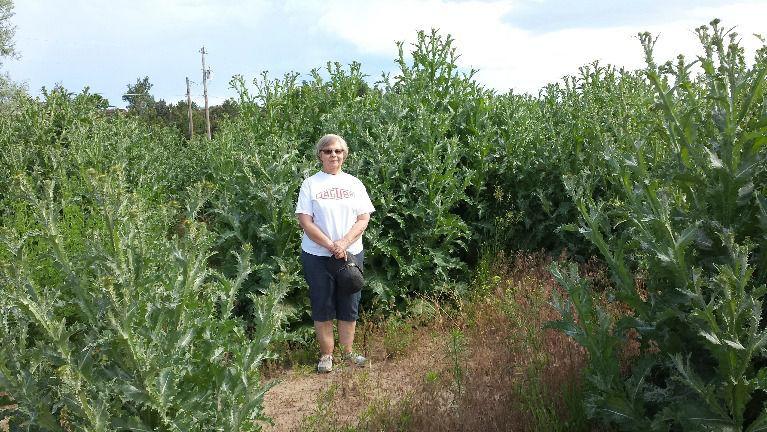Weed Management
What is the Town's position on weed management?
ALL LIST A WEEDS MUST BE ERADICATED. Currently, Myrtle Spurge is the only List A noxious weed found within the Town. All other weeds, both from the State list and those locally declared a nuisance, must, at a minimum, be mowed. Please keep in mind that mowing is not effective on low growing weeds such as Puncturevine or weeds that have aggressive root systems. Also, different weeds have different growth cycles. For all noxious weeds it is essential to determine the growing cycle and appropriate timing for optimum management and control. Weeds should be mowed in the spring and again as necessary. If they are not controlled before going to seed, the wind will spread these weeds throughout the Town and neighboring communities.
Noxious and Nuisance Weeds
The Colorado Noxious Weed Act states that certain noxious weeds pose a threat to the natural resources of Colorado and that it is the duty of all persons to manage noxious weeds. These weeds affect local wildlife, invade open space, can be poisonous to livestock and horses, irritating to human skin and dangerous for pets. In accordance with this Act, the Board of Trustees adopted an ordinance providing for the management and control of noxious weeds
What is a noxious weed?
The Act defines a noxious weed as an alien plant or parts of an alien plant that has been designated by rule as being noxious and meets one of the following additional criteria:
- Aggressively invades or is detrimental to economic crops or native plant communities.
- Is poisonous.
- Is a carrier of detrimental insects, diseases or parasites.
- The direct or indirect effect of the presence of these plants is detrimental to the environmentally sound management of natural, open space or agricultural ecosystems.
How are the weeds categorized?
Commissioner of the Colorado Department of Agriculture (CDA) has declared the noxious weed list for the State. The list is divided into 3 categories:
List A: Rare noxious weeds that are subject to eradication wherever detected statewide in order to protect neighboring lands and the state as a whole.
List B: Noxious weed species with discrete statewide distributions that are subject to eradication, containment or suppression in portions of the State designated by the Commissioner in order to stop the continued spread of these species.
List C: Widespread and well-established noxious weed species for which control is recommended but not required by the State, although local governing bodies may require management. While the Town of Foxfield has opted to require control of only Common Mullein on List C, residents are encouraged to do their best to control other List C noxious weeds.
| COMMON NAME | CLASS | MANAGEMENT |
|---|---|---|
| Myrtle Spurge | List A | Eradicate |
| Canada Thistle | List B | Control |
| Musk Thistle | List B | Control |
| Scotch Thistle | List B | Control |
| Dalmatian Toadflax | List B | Control |
| Diffuse Knapweed | List B | Control |
| Russian Knapweed | List B | Control |
| Leafy Spurge | List B | Control |
| Common Mullein | List C | Control |
| Puncturevine | List C | Voluntary Control |
| Field Bindweed | List C | Voluntary Control |
| Redstem Filaree | List C | Voluntary Control |
| Downy Brome | List C | Voluntary Control |
How are noxious and nuisance weeds managed?
Through an Integrated Management Plan which is a process by which one selects and applies a combination of management techniques that, together, will control a particular weed species or infestation efficiently and effectively, with minimal adverse impacts to non-target organisms.
What are the different management strategies?
Management strategies include any activity that prevents a plant from establishing, reproducing or dispersing itself and include prevention, eradication and control methods of containment and/or suppression.
Prevention: The first line of defense to keep weeds from occurring or increasing. It includes using measures that will prevent the introduction or establishment of noxious weeds into areas not currently infested. This is the most practical and cost effective means of weed management.
Eradication: The removal of weeds from an area so they will not recur unless reintroduced. ALL LIST A WEEDS MUST BE ERADICATED.
Control (containment and suppression): Control reduces a weed population to a level where you can enjoy using the land. There are four control methods:
- Biological: The use of an organism to disrupt the growth of noxious weeds. Grazing is effective on some species.
- Cultural: Management practices which favor the growth of desirable plants over noxious weeds such as maintaining healthy pastures and preventing bare spots by seeding areas with competitive grasses.
- Mechanical: Methods that physically disrupt plant growth.
- Herbicidal: The use of herbicides or plant growth regulators to disrupt the growth of noxious weeds.
Combining control methods and persistent management is critical to control both noxious and nuisance weeds.
Please visit the Department of Agriculture website for detailed information at www.colorado.gov/ag/weeds.
For information on spraying and chemical control, please contact a licensed herbicide contractor.

